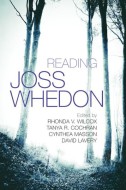Book Review: Reading Joss Whedon
Reading Joss Whedon
Edited by Rhonda V. Wilcox, Tanya R. Cochran, Cynthea Masson & David Lavery
Syracuse University Press, 2014
ISBN: 9780815633648
461 p.
Beginning with the 1997 premiere of the television series Buffy the Vampire Slayer, Joss Whedon has benefited from a devoted yet critical following. Within a couple of years of the show’s premiere, episodes, characters, and even lines of dialogue were voraciously dissected and analyzed in small online communities such as WHEDONesque, a website solely dedicated to discussions of Whedon’s creative work. While it is not uncommon for a television show to generate a passionate following, what is remarkable here is that Whedon’s work also piqued the interest of scholars and academics. Just two years after Buffy aired, articles appeared in academic journals analyzing the television show. By the time the final episode aired in 2003 “Whedon Studies” had become a small yet fervent discipline spawning articles, conferences and even its own peer-reviewed journal Slayage. Reading Joss Whedon, a critical anthology edited by some of the architects of Whedon Studies, offers an exciting, engaging snapshot of the work produced by scholars in this growing area of study.
The title suggests this book will examine the entirety of Whedon’s oeuvre and for the most part it succeeds in doing so. The book is divided into sections, the first four of which cover Whedon’s major television works Buffy, Angel (a spin-off of Buffy), Firefly (along with its follow-up film Serenity) and Dollhouse. Another section touches upon Whedon’s work in other media such as film (Cabin in the Woods, The Avengers), web series (Dr. Horrible’s Sing-Along Blog), and comic books (Buffy the Vampire Slayer Season 8), with the final section devoted to studies examining themes manifested in several works. To aid researchers, the editors have provided a second table of contents that organizes the chapters by topic (narrative and writing, visuals and directing, myth, gender, etc.). Even the film adaptation of Much Ado about Nothing, the most recent work completed prior to the book’s publication, is accounted for in an excellent introduction by Wilcox, who uses the film to investigate recurring themes and motifs in Whedon’s work. While it would have been nice for a chapter to examine Whedon’s other work in comics, such as Sugarshock! or Fray, this is a minor complaint in an otherwise comprehensive work.
Not only is the coverage extensive, the scholarship is universally excellent as well. Of particular interest to theatre scholars may be Cynthea Masson’s chapter “What the Hell?: Angel’s “The Girl in Question,” which positions the piece as an existential drama, comparing it to Waiting for Godot and No Exit. While all the chapters are insightful, the final section offers the most exciting scholarship and draws from all of Whedon’s work to investigate concepts of ethics, identity construction and memory. The final section includes Tanya R. Cochran’s thorough account of the field of Whedon Studies to date.
The accessible subject matter married with rigorous, well-research academic writing offers a work that is an ideal entry point for undergraduate researchers in critical studies. This work is highly recommended for libraries supporting programs in television, film or popular culture.
Michael Saar
Lamar University

